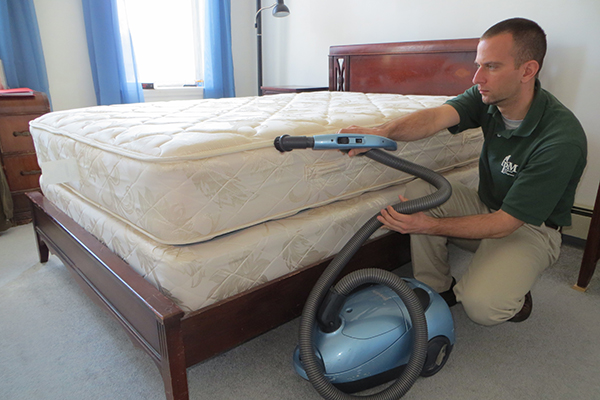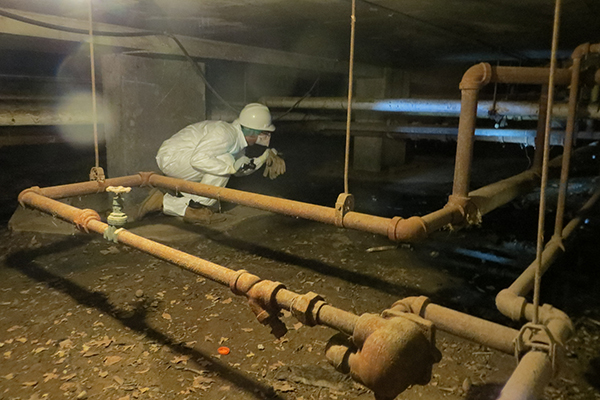


Rat research
UD alumnus finds potentially dangerous fleas on New York City rats
1:12 p.m., March 3, 2015--When University of Delaware alumnus Matt Frye signed on to work with researchers from Columbia University studying pathogens of Norway rats in New York City, he knew that as the team’s entomologist he would be combing the rats for critters such as fleas, lice and mites.
What he didn’t know was that he would find such a high rate of the oriental rat flea -- an insect that hasn’t been documented in New York since the 1920s and is a known vector for several important human diseases such as murine typhus and the plague.
Research Stories
Chronic wounds
Prof. Heck's legacy
The results of these findings were reported recently in the Journal of Medical Entomology.
Despite their name, Frye explained that Norway rats actually come from Asia and through the years have traveled the world with humans on wagons and trade ships, carrying a familiar set of ectoparasites as they make their way across the globe.
“Studies that are specifically interested in rat ectoparasites tend to find the same cast of characters,” said Frye. For example, researchers in Hawaii -- Pingjun Yang, Sandra Oshiro and Wesley Warashina from the Hawaii Department of Health --published a paper in 2009 that found all the same ectoparasites on their rats that Frye and the Columbia research team found in New York.
“We were not necessarily surprised to find any of these critters, but we were surprised at the numbers that we found,” said Frye, an extension educator with the New York State Integrated Pest Management (IPM) Program at Cornell University
The group collected the data over a one-year period from five different sites in the city, specifically areas where rats and humans are most likely to have direct contact with one another.
All told, Frye took samples from 133 rats and collected a total of 545 fleas. Of those 133 rats, he said that about 30 percent were infested with fleas.
“The interesting thing is that the fleas were unevenly distributed by site. At the outdoor site, a single flea was collected from 26 rats. Meanwhile, all 20 rats from another site had fleas, and that site accounted for 94.1 percent of the total 545 fleas we collected,” said Frye. “The implication is that a more thorough survey of rats is needed to understand the distribution of ectoparasites in New York City.”
At the site where all 20 rats had fleas, Frye collected 83 fleas from just one rat, which could be cause for alarm according to plague surveillance literature. Frye said that a flea index -- the total number of fleas divided by the total number of rodents captured -- below 1.0 represents a remote possibility of a disease outbreak.
“In 1925 in New York, the flea index was 0.22. In our study, the index was 4.1 for all 133 rats, and 5.1 for rats caught indoors. That was surprising,” he said.
However remote, the potential exists for diseases like murine typhus and the plague to surface, Frye said, noting, “We have the rats, we have the vector that can transfer pathogens from the rats to humans, so it’s sort of a recipe for disaster if plague or typhus were introduced.”
Frye is hoping that the revelation of the high numbers of oriental rat fleas discovered in New York City’s rat population will lead to more research on the subject.
“The purpose of this study was to take a first look at what pathogens and ectoparasites are present on Norway rats New York City,” said Frye. “However, our study was limited in scope, and has led to more questions than answers. For instance, we do not know the distribution of these organisms, nor do we know if the conditions are right to sustain something like plague. What we do know is that more work is needed to better understand the risk of exposure to rodent-borne disease for New Yorkers.”
The researchers also discovered several new species of viruses and some pathogens that haven’t been recorded before in New York City. The results of those findings were released in a paper published last year by the American Society for Microbiology.
The viruses are listed as two novel hepaciviruses, one novel pegivirus and one novel pestivirius. Frye explained because the viruses are new and were detected using novel screening methods, the researchers “don't know much about the viruses and if or how they might impact human health.”
Time at UD
While at UD, Frye worked with Judy Hough-Goldstein, professor of entomology, for six years studying biological control of invasive plants, specifically kudzu, as both a master’s and doctoral student.
As a master’s student, Frye conducted research on a specific insect and its potential to control the plant -- which ultimately didn’t work out due to the insect’s appetite for soybeans -- and as a doctoral level student, he looked at different types of damage with kudzu to see if any reduced the plant’s growth and reproduction.
Frye said that his time at UD working with Hough-Goldstein and the Department of Entomology and Wildlife Ecology was beneficial to his career.
“Our department at the time was relatively small, so there was a lot of interaction between graduate students and faculty that I found to be exceptionally valuable. I felt very fortunate to have Dr. Hough-Goldstein as an adviser, because she was very organized and helped her students develop as scientists,” said Frye.
In his role with the New York State IPM Program, Frye said that he provides training, demonstrations, workshops and creates educational materials about pest management and specifically structural or urban pest management, which deals with the insects that infest buildings, schools and homes.
He said that his favorite part of his job is “working with people. I get to interact with homeowners, with universities, and pest professionals. Helping people find a solution to their pest problem is a very rewarding experience.”
Article by Adam Thomas









